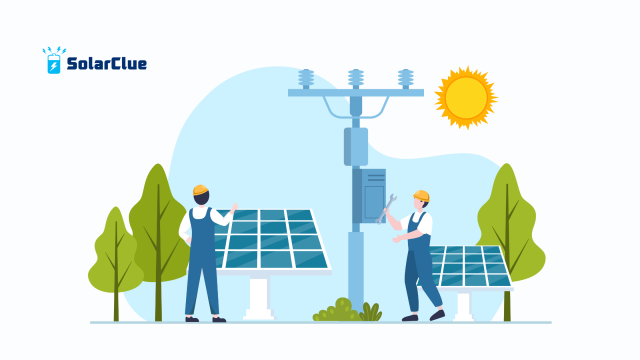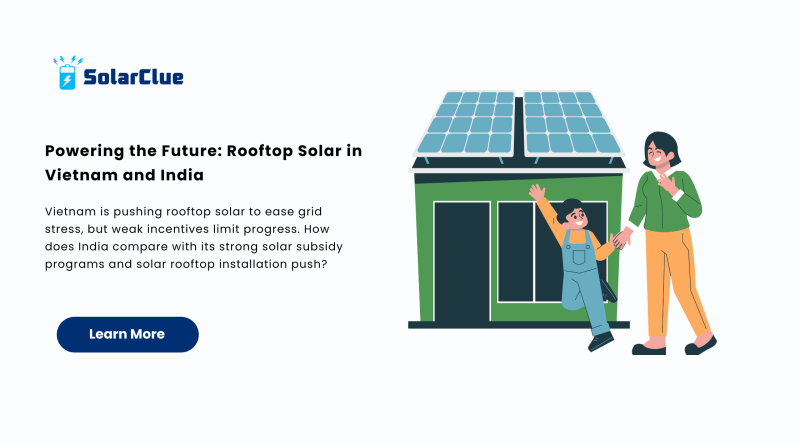Powering the Future: Rooftop Solar in Vietnam and India
Powering the Future: Rooftop Solar in Vietnam and India. As the global energy demand continues to surge, countries like Vietnam and India are turning to renewable solutions, especially solar panels, to ease the stress on traditional power grids. Vietnam recently set its sights on expanding rooftop solar installations to relieve pressure on its overburdened grid. However, a closer look reveals that Vietnam’s efforts are hindered by inadequate financial support, unclear policies, and limited accessibility.
On the other hand, India stands out for its proactive approach toward promoting solar rooftop installations through attractive solar subsidy schemes, clear policy frameworks, and national-level support systems. This blog explores the challenges Vietnam faces, how India’s model differs, and what lessons both countries can learn from each other in their journey toward sustainable energy.
Table of Contents
- 1 Vietnam’s Rooftop Solar Push: A Step Forward with Missing Links
- 2 India’s Solar Growth Story: A Model Worth Emulating
- 3 Why India is Leading in Rooftop Solar Installations
- 4 Key Comparison: Vietnam vs India in Rooftop Solar
- 5 Lessons for Vietnam from India’s Solar Journey
- 6 India’s Next Big Leap in Rooftop Solar
- 7 Conclusion: The Power of Policy in Shaping Solar Futures
- 8 FAQs
Vietnam’s Rooftop Solar Push: A Step Forward with Missing Links
In response to the country’s frequent power shortages, Vietnam is eyeing an ambitious rooftop solar expansion plan. The government has encouraged households and businesses to install solar rooftops to reduce dependency on centralized power supply. However, Vietnam’s current incentive structure has proven to be insufficient to trigger a large-scale transformation.
Here are the major bottlenecks in Vietnam’s rooftop solar policy:
-
Lack of Feed-in Tariff (FiT): The absence of an attractive FiT discourages many from investing in solar energy.
-
High Upfront Costs: Without government subsidies or financing options, the initial cost of installing solar panels remains a major barrier.
-
Policy Ambiguity: Unclear and frequently changing policies create uncertainty for both consumers and solar businesses.
-
No Net Metering Clarity: Net metering remains under-defined, making it harder for rooftop users to feed surplus power back to the grid efficiently.
Despite Vietnam having high solar potential, especially in the central and southern regions, its policy framework lacks the comprehensive push that would incentivize adoption at scale.
India’s Solar Growth Story: A Model Worth Emulating
India, in contrast, has made tremendous progress in the solar sector, thanks to focused policy implementation, active government support, and effective use of solar subsidies. The PM Surya Ghar Muft Bijli Yojana, launched in 2024, aims to bring rooftop solar to 10 million households by offering up to ₹78,000 in subsidies for systems up to 3 kW.
Why India is Leading in Rooftop Solar Installations
1. Attractive Solar Subsidies:
India’s subsidy structure is robust and transparent. Residential consumers installing up to 3 kW can avail up to 40% subsidy, while systems between 3 to 10 kW receive 20% subsidy under the central government scheme. This brings down the effective cost significantly.
2. Digital Solar Portals:
Portals like the National Rooftop Solar Portal and solarclue.com provide easy access to application processes, approved vendors, and subsidy tracking, eliminating bureaucratic hurdles.
3. Net Metering Policies:
India has a relatively streamlined net metering policy. Consumers can offset their energy bills by sending surplus power back to the grid, encouraging more people to invest in solar rooftop systems.
4. Widespread Awareness and Outreach:
Awareness programs and market-driven promotions through platforms like blog.solarclue.com help in educating both urban and rural households on the benefits of solar panels and long-term energy savings.
5. Financing and Loans:
Several banks and NBFCs in India offer solar loans with reduced interest rates and flexible repayment options.

Key Comparison: Vietnam vs India in Rooftop Solar
| Parameter | Vietnam | India |
|---|---|---|
| Government Subsidy | Minimal or none | Up to 40% for residential systems |
| Net Metering | Unclear and inconsistent | Well-defined and state-supported |
| FiT Policy | Absent | Available in select states |
| Financing Options | Limited | Multiple banks and NBFCs offer support |
| Market Awareness | Low | High, with aggressive promotion campaigns |
| Digital Platforms | Underdeveloped | Centralized national portal for all steps |
| Grid Integration | Challenging due to weak infrastructure | Improved infrastructure for grid feedback |
Lessons for Vietnam from India’s Solar Journey
To achieve its renewable energy goals, Vietnam can adopt several best practices from India:
-
Implementing structured solar subsidy programs with tier-based incentives.
-
Promoting solar rooftop installations via educational drives and digital platforms.
-
Creating a centralized national solar portal for application, installation, and maintenance tracking.
-
Ensuring policy consistency and providing clarity on net metering and FiT.
India’s Next Big Leap in Rooftop Solar
India’s rooftop solar potential is immense, with an estimated 43 GW capacity yet to be tapped. With rising electricity costs and growing environmental awareness, more homeowners and businesses are turning toward solar panels.
Here’s how India can scale even further:
-
Enhance storage infrastructure by integrating batteries for energy backup.
-
Incentivize commercial and industrial rooftops to adopt large-scale systems.
-
Encourage R&D in solar efficiency to improve output even in cloudy or polluted regions.
-
Boost state-level implementation by encouraging DISCOMs to support rooftop solar through simplified processes and active consumer engagement.
Conclusion: The Power of Policy in Shaping Solar Futures
Vietnam’s intention to expand solar rooftop installations is a commendable step. But without strong policy support and financial incentives, adoption will remain slow. India, on the other hand, is reaping the benefits of a well-structured solar subsidy ecosystem that empowers consumers, supports vendors, and strengthens the energy grid.
Countries with similar challenges can learn from India’s solar journey and tailor it to their needs. In the end, it’s not just about installing solar panels—it’s about building a system that supports every stakeholder in the renewable energy ecosystem.
Curious how you can make the most of solar subsidy benefits in India? Visit solarclue.com or explore expert insights at blog.solarclue.com and power your home the smarter way today.
FAQs
1. What is the current solar subsidy for residential consumers in India?
Under the PM Surya Ghar scheme, you can receive up to ₹78,000 for systems up to 3 kW and 20% subsidy for systems between 3 to 10 kW.
2. How does net metering work in India?
Net metering allows you to feed excess solar energy back into the grid. The energy you export is deducted from your monthly electricity bill.
3. Is there any subsidy available in Vietnam for rooftop solar?
Currently, Vietnam lacks structured subsidies and feed-in tariff support for residential solar users, which is slowing down adoption.
4. How do I apply for a rooftop solar subsidy in India?
You can apply through the National Rooftop Solar Portal or get support from platforms like solarclue.com.
5. Which is better for residential solar installation: India or Vietnam?
In terms of government support, structured subsidies, and policy clarity, India offers a more favorable environment for residential solar users.




